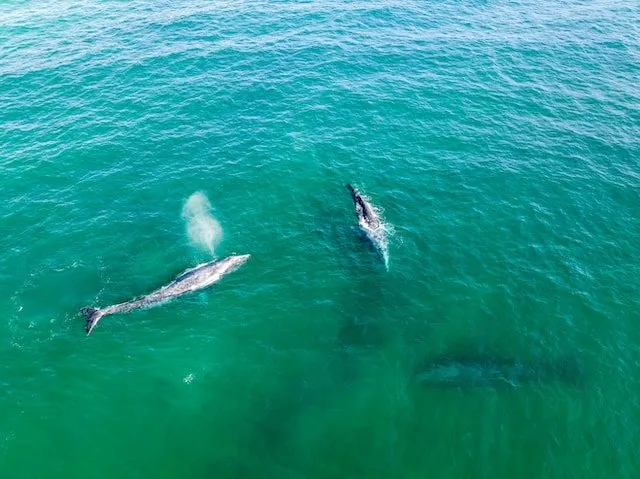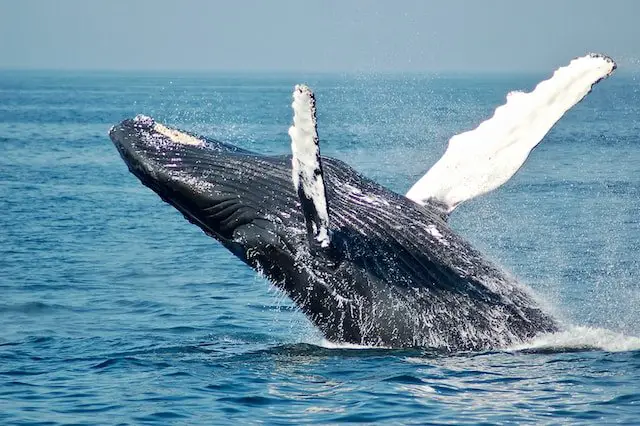As an Amazon Associate I earn from qualifying purchases.
In the enigmatic depths of the ocean, where the sun’s rays barely penetrate, a mesmerizing ballet unfolds. It’s a story of survival, epic migrations, and a diet that sets the stage for one of the sea’s most enchanting characters. “What do Gray whales eat?” Gray whales, renowned for their epic migrations and gentle nature, have a dietary preference that sets them apart in the marine world. In this article, we’ll deeply dive into the fascinating world of gray whale feeding habits, breaking down their diet into various food sources and explaining the importance of these choices in supporting these majestic creatures throughout their awe-inspiring journeys. Join us as we unveil what nourishes gray whales during their remarkable migrations and the intricate web of marine life that sustains them.
What Do Gray Whales Eat?
Gray whales, often recognized for their impressive migrations and friendly demeanor, have a fascinating diet that supports their massive size and long journeys. Understanding what gray whales eat is not only essential for marine biologists but also for nature enthusiasts eager to learn more about these majestic creatures. In this blog post, we’ll delve into what gray whales eat, breaking down their diet into different food items that keep them nourished during their incredible migrations.
1. Amphipods:
Gray whales are primarily filter feeders, and their diet largely consists of tiny marine organisms called amphipods. Amphipods are small, shrimp-like crustaceans that form the core of the gray whale’s diet. Gray whales feed on amphipods by swimming through dense patches of these small creatures with wide open mouths. Their baleen plates, made of keratin, trap the amphipods while letting water escape. This specialized feeding technique is highly effective and allows gray whales to consume thousands of amphipods in a single mouthful.
2. Isopods:
Isopods are another crucial component of the gray whale’s diet. These small, flattened crustaceans are abundant in the shallow, nutrient-rich waters of the Arctic and Bering Sea. Gray whales actively seek out areas with high concentrations of isopods during their feeding seasons. Like amphipods, gray whales filter isopods from the water, straining them through their baleen plates for a nutrient-rich meal.
3. Tube Worms:
While amphipods and isopods comprise the bulk of the gray whale’s diet, they also consume other organisms, including tube worms. Tube worms are typically found near hydrothermal vents on the ocean floor. Gray whales have been observed feeding on these tubeworms during their migrations, showcasing their adaptability to different food sources.
4. Mysids:
Mysids, or opossum shrimp, are another important prey for gray whales, especially in their southern feeding grounds. These tiny crustaceans are a nutritious part of the gray whale’s diet and are an abundant food source in various marine environments.
5. Crustaceans and Larval Fish:
Gray whales have been known to consume other small crustaceans and larval fish on occasion. While these items may not make up a significant portion of their diet, they demonstrate the gray whale’s flexibility in foraging for food.
Do gray whales hunt?
Gray whales are not typically considered predatory hunters like some other whale species. They are primarily filter feeders with a dietary preference for small, planktonic organisms, which they filter from the water using their baleen plates. However, it’s essential to explore their hunting behaviors in more detail to provide a comprehensive understanding of gray whales’ feeding habits.
1. Filter Feeding:
Gray whales are best known for their filter-feeding technique, which sets them apart from many other cetaceans. Their primary prey includes tiny marine organisms such as amphipods, isopods, mysids, and other small crustaceans. To capture these organisms, gray whales swim through dense prey patches with wide open mouths. As they do so, they use their baleen plates to strain the water, trapping the prey inside their mouth while allowing water to flow. This unique and efficient method allows gray whales to consume large quantities of planktonic organisms in one feeding attempt.
2. Surface Grazing:
Gray whales are often observed surface grazing in shallow waters, particularly in their summer feeding grounds in the Arctic. During this activity, they skim the seafloor, using their upper jaw and baleen plates to capture amphipods and other bottom-dwelling organisms. This behavior might resemble hunting, as the whales actively seek out their prey on the seafloor.
3. Opportunistic Feeding:
While gray whales primarily feed on small crustaceans and plankton, they are opportunistic feeders and have been known to consume other food items when available. This may include tube worms found near hydrothermal vents on the ocean floor or occasional consumption of small fish or other invertebrates. These opportunistic behaviors demonstrate the adaptability of gray whales when it comes to foraging.
4. Mother-Calf Behavior:
Gray whale calves rely on their mother’s milk for the first few months of their lives, and their mothers do not hunt in the traditional sense during this period. The mothers typically fast during the nursing period, relying on their energy reserves to produce milk. Once the calves are weaned, they gradually transition to a diet of planktonic organisms like their adult counterparts.
Gray whales are not classified as predatory hunters; they exhibit specialized feeding behaviors adapted to their primary diet of small planktonic organisms. These behaviors include filter feeding, surface grazing, and opportunistic feeding. Their unique feeding habits are a testament to the adaptability of these remarkable marine mammals, allowing them to thrive in the diverse ecosystems they inhabit.
How Do Gray Whales Impact Our Ecosystem?
Gray whales play a vital role in marine ecosystems, and their impact is multi-faceted, influencing various aspects of the environment in which they reside. Below, we’ll explore how gray whales impact our ecosystem in greater detail.
1. Nutrient Cycling:
Gray whales contribute significantly to nutrient cycling in marine ecosystems. They are filter feeders primarily consuming small planktonic organisms like amphipods, isopods, and mysids. As they feed, they take in these tiny organisms and absorb their nutrients. When gray whales defecate, they release these nutrients into the water, fertilizing the ocean with essential elements like nitrogen and iron. This, in turn, enhances primary productivity by promoting the growth of phytoplankton and other marine plants. Increased primary productivity at the base of the food chain benefits various marine species, creating a ripple effect throughout the ecosystem.
2. Trophic Cascade:
Gray whales can indirectly impact the entire food web through what is known as a trophic cascade. By influencing the abundance of their prey, such as amphipods and mysids, gray whales can affect the populations of other organisms in the ecosystem. When gray whales feed heavily on these prey species, it can reduce their numbers, increasing competition among other marine animals that rely on the same food sources. This can ultimately affect the distribution and abundance of various species within the ecosystem.
3. Benthic Disturbance:
While feeding in shallow waters, especially in their Arctic feeding grounds, gray whales engage in surface grazing, using their upper jaw and baleen plates to capture bottom-dwelling organisms. This behavior can result in minor disturbances to the benthic (seafloor) communities. While these disturbances are not harmful in moderation and can even be beneficial in certain cases, excessive or repeated surface grazing in specific areas may alter the composition of benthic communities.
4. Prey Population Control:
Gray whales may help control the populations of their primary prey, such as amphipods and isopods. By predating on these small crustaceans, gray whales can help regulate their numbers, preventing population explosions that could negatively affect the ecosystem. This natural predation can help maintain a balanced prey-predator relationship in the marine environment.
5. Food for Other Species:
Gray whales themselves provide a valuable food source for a variety of predators, including orcas (killer whales) and large sharks. The presence of gray whales in certain regions can attract these predators, contributing to the overall diversity and health of the ecosystem.
Final Words
The captivating world of gray whales and their dietary habits is a remarkable testament to the intricate web of life that thrives beneath the ocean’s surface. By delving into the question, “What do gray whales eat?” We’ve uncovered not only the specifics of their diet but also the profound impact they have on the marine ecosystems they inhabit. From nutrient cycling and trophic cascades to their role as a valuable food source for other species, gray whales are central to the delicate balance of life in the world’s oceans. Understanding their place in this intricate puzzle underscores the significance of conservation efforts to protect these gentle giants and the diverse marine environments they call home. Gray whales are more than just magnificent creatures; they are living indicators of the health and vitality of our oceans.
You can also read:
1.What Do Belgian Malinois Eat? A Diet Guide for Optimal Health
2.What Do Teacup Puppies Eat? From Bowl to Bliss
3.What do Alaskan Malamutes eat? A Balanced Diet for Alaskan Malamutes
4.What Do Birman Cats Eat? Exploring Birman Cat Cuisine
Amazon and the Amazon logo are trademarks of Amazon.com, Inc, or its affiliates.



